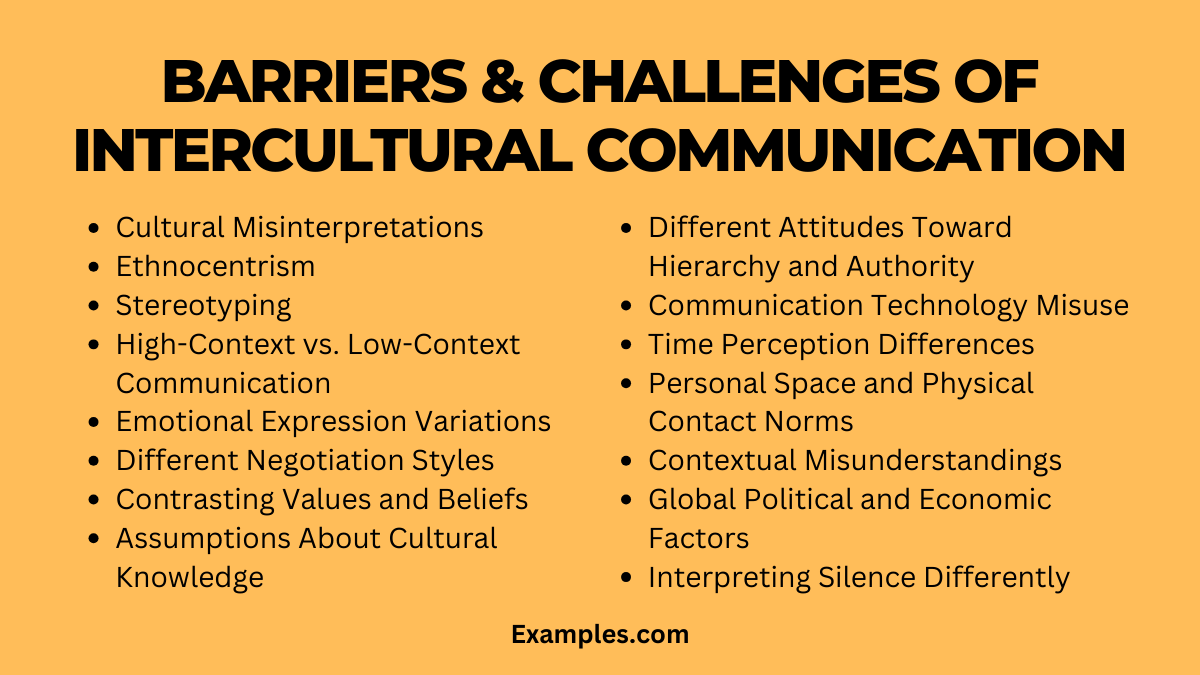19+ Barries & Challenges of Intercultural Communication
Understanding the barriers and challenges in Intercultural Communication is essential in a globalized world. These challenges range from language barriers and cultural misunderstandings to differences in communication styles and nonverbal cues. Recognizing and overcoming these obstacles is key to effective communication across cultures. This guide will explore the various challenges faced in intercultural interactions and provide insights on how to navigate them successfully, enhancing communication skills and fostering mutual understanding in diverse settings.
What are Barriers & Challenges of Intercultural Communication?

Barriers and challenges in Intercultural Communication refer to the obstacles that hinder effective interaction between people from different cultural backgrounds. These challenges can include language differences, cultural misinterpretations, ethnocentrism, and differing communication styles. Overcoming these barriers is crucial for successful intercultural communication, as it leads to better understanding, collaboration, and relationships in both personal and professional contexts. Identifying and addressing these challenges is the first step towards effective intercultural communication.
List of Barriers & Challenges of Intercultural Communication

Intercultural Communication involves navigating a complex array of barriers and challenges. These obstacles can significantly impact the effectiveness of communication between individuals from different cultural backgrounds. Understanding these challenges is crucial for developing strategies to overcome them, thereby enhancing mutual understanding and collaboration in diverse settings. From language differences to nonverbal misinterpretations, these barriers highlight the need for cultural sensitivity and adaptability in global interactions.
- Language Barriers: Misunderstandings due to language differences are common in intercultural communication.
“I struggled to explain my point in English, which isn’t my first language.” - Cultural Misinterpretations: Misinterpreting cultural norms can lead to confusion and offense.
“My casual greeting was misinterpreted as disrespect in a formal culture.” - Ethnocentrism: Viewing one’s own culture as superior can hinder understanding and respect.
“Assuming my cultural norms were ‘the right way’ limited my understanding of others.” - Stereotyping: Stereotypes can lead to oversimplified and often incorrect assumptions.
“Being stereotyped due to my nationality made it hard to express my individuality.” - Nonverbal Communication Differences: Nonverbal cues vary across cultures, leading to misinterpretations.
“My thumbs-up gesture was interpreted negatively in a different cultural context.” - High-Context vs. Low-Context Communication: Misalignments in communication styles can cause confusion.
“Coming from a low-context culture, I found the indirect communication style challenging.” - Emotional Expression Variations: Different cultures express emotions in varied ways.
“In my culture, showing emotions is common, but it was misunderstood as unprofessional.” - Different Negotiation Styles: Negotiation approaches can vary significantly across cultures.
“My direct negotiation style was perceived as aggressive in a more reserved culture.” - Contrasting Values and Beliefs: Differing values and beliefs can lead to conflicts or misunderstandings.
“Our different religious beliefs led to a misunderstanding during the festival.” - Assumptions About Cultural Knowledge: Assuming a shared cultural knowledge can lead to miscommunication.
“I referenced a local holiday, not realizing others were unfamiliar with it.” - Different Attitudes Toward Hierarchy and Authority: Varying perceptions of hierarchy can impact interactions.
“In my culture, questioning authority is rare, so I was hesitant to speak up.” - Communication Technology Misuse: Misuse or overreliance on communication technology can hinder personal connections.
“Relying too much on emails led to a lack of personal connection.” - Time Perception Differences: Attitudes towards time and punctuality vary, affecting scheduling and interactions.
“My punctuality was perceived differently in a culture with a more relaxed view of time.” - Different Approaches to Conflict Resolution: Cultures have different ways of handling conflicts, which can complicate resolution.
“I preferred a direct approach to conflict, while my colleague avoided confrontation.” - Personal Space and Physical Contact Norms: Variations in personal space and physical contact can lead to discomfort.
“Coming from a culture with larger personal space, I was uncomfortable with close interactions.” - Contextual Misunderstandings: Misunderstanding the context of a situation can lead to incorrect interpretations.
“I misinterpreted a formal meeting as casual, leading to an awkward interaction.” - Educational and Professional Background Differences: Diverse educational and professional experiences can affect communication styles.
“Our different educational backgrounds meant we had different approaches to problem-solving.” - Global Political and Economic Factors: Global events can influence intercultural interactions and perceptions.
“Political tensions between our countries made our business negotiations more challenging.” - Historical and Social Context Misunderstandings: Lack of awareness of historical and social contexts can affect communication.
“I was unaware of the historical sensitivities, which affected our discussion.” - Interpreting Silence Differently: Silence is interpreted differently in various cultures, affecting communication.
“In my culture, silence is contemplative, but it was seen as disinterest.”
These examples illustrate the breadth of challenges in Intercultural Communication, emphasizing the need for cultural awareness, empathy, and adaptability to navigate these effectively.
Navigating the barriers and challenges of intercultural communication is crucial for effective global interactions. This guide has provided insights into common obstacles and offered practical strategies for overcoming them. Emphasizing the importance of cultural sensitivity and adaptability, it encourages readers to engage in mindful and respectful communication, fostering better understanding and cooperation in our increasingly interconnected world.



